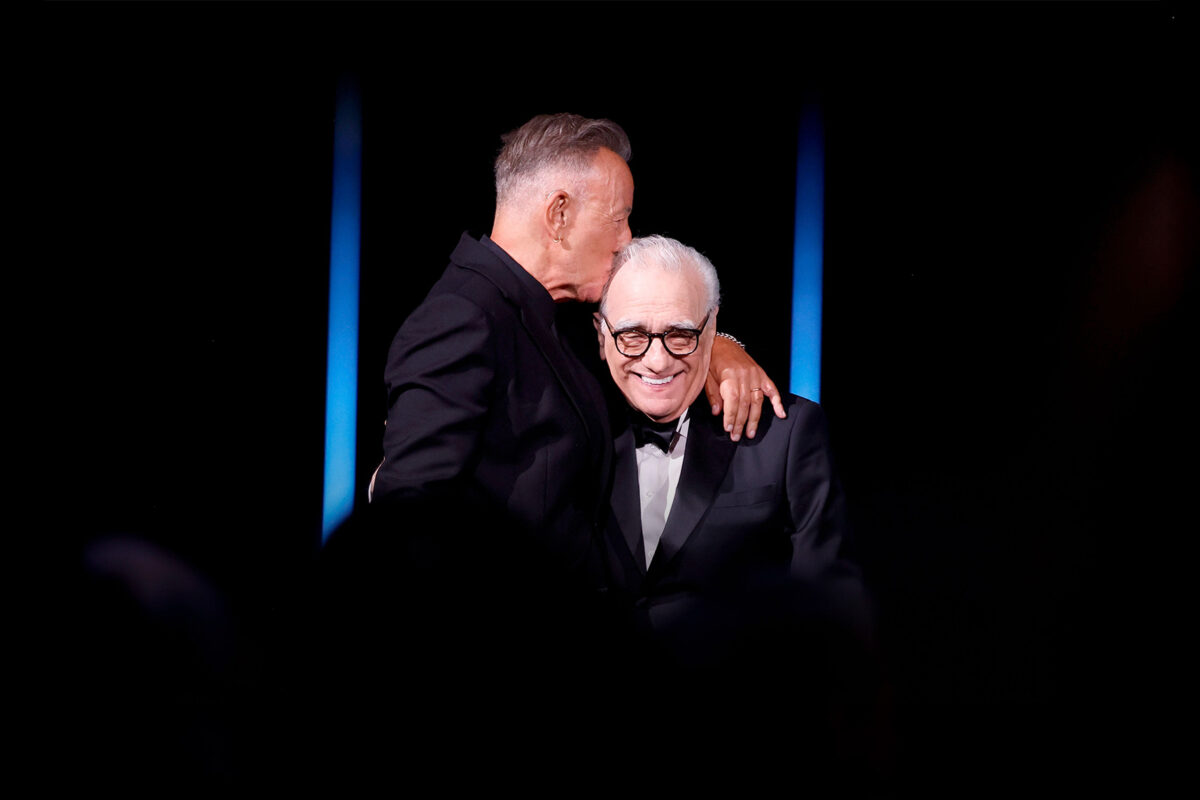California’s tech elite and business brains are buying up the nation’s most esteemed newspapers and magazines with no guarantees they’ll ever turn a profit. What’s in it for them?
Words by JOHN ARLIDGE
Illustration by GLUEKIT
Every self-respecting Californian billionaire needs a side hustle. Larry Page, Google’s co-founder, is personally funding secretive flying-car startup Kitty Hawk. Oracle co-founder Larry Ellison’s passion is “life extension.” Want to live forever? Click here. Jeff Bezos, Amazon’s founder, who is the world’s richest man, worth $157 billion, is investing about $1 billion a year in Blue Origin, his space exploration company. Elon Musk also has his own rockets, which he wants to use to help mankind conquer Mars.
Other West Coast whizzes have ambitions that are a little more down-to-earth—trying to figure out how to make money in one of the oldest and most troubled industries: print media. San Francisco’s serial investor and the founder of Salesforce, Marc Benioff, worth nearly $6 billion, and his wife, Lynne, bought one of the greatest historic media brands, Time magazine, in September from Meredith Corporation for $190 million. He now joins the ranks of new barons whom observers have dubbed “the new Hearsts”—after William Randolph Hearst, who inherited The San Francisco Examiner from his father in 1887 and went on to build the world’s first modern media empire, becoming the inspiration for Charles Foster Kane in Orson Welles’ film Citizen Kane.
Among this new Californian cadre are part-time L.A. resident Bezos, who bought The Washington Post with $250 million of his private fortune in 2013; L.A.-based biotech entrepreneur Patrick Soon-Shiong, who snapped up the Los Angeles Times and The San Diego Union-Tribune for $500 million from the Chicago-based Tribune Media Company this past June; Palo Alto-based Laurene Powell Jobs, the philanthropist and widow of Apple’s co-founder, Steve Jobs, who took a majority stake in The Atlantic magazine in 2017; and Venice’s Jay Penske, scion of the Penske automotive dynasty, who has Rolling Stone, Variety and fashion industry bible WWD in his collection.
Wealthy people have a long history of investing in newspapers. Fortunes have been made. Reputations have been won—and lost. But for the new technology moguls, the benefits are not immediately obvious. Tech is the essence of modernity—the newest of the new, new thing. To many in Silicon Valley, newspapers and magazines are relics of an ancient business landscape that they have done so much to sweep away and replace with something more dynamic and consumer focused. What’s driving the interest?
“The people with the money are in tech … publishers are happy to hold their noses and take the cash.”
—Kyle Pope, Columbia Journalism Review
Kyle Pope, editor-in-chief and publisher of the Columbia Journalism Review, argues: “Rich people seeking to scrub their legacies have always been interested in big media brands. It’s been around since there has been money and news. Now, the people with the money are in tech. The irony, obviously, is that many of them have spent their careers building companies determined to put print journalism out of business. So we have come full circle. And, given the business pressures of print, publishers are happy to hold their noses and take the cash.”
Rohan Silva, a tech investor based in L.A. and London, says the investments chime with the billionaires’ “problem-solving mindset, desire to do good, and ego, too. They’ve built their businesses by setting ambitious goals and using an engineering mindset to achieve them. Right now, media faces a host of problems—and these entrepreneurs feel they can solve them.”
Print titles present a monumental challenge. Circulations are shrinking. Advertising dollars continue to migrate from paper and ink to the web. Accountancy PwC forecasts print advertising revenue for newspapers will fall to $6.9 billion in the United States by 2022, less than half the $17.6 billion they generated in 2013. Media titles are also battling for credibility when high-profile critics—notably the most visible man in the world, President Donald Trump—are quick to accuse them of publishing fake news.
Silicon Valley is in part to blame for these problems. News is widely available online for free. Google and Facebook are the world’s largest advertising companies and Facebook and Twitter have become a platform for critics who accuse journalists of “fakery.” In these partisan times, politics are at work too. Many tech billionaires are Democrats and regard traditional media as a bulwark against the Republican digital onslaught driven by POTUS, aka the Tweeter-in-Chief. The Democrats’ retaking of the House of Representatives in the midterm elections offers encouragement to Silicon Valley opponents of the president.
In September, Bezos called out Donald Trump’s criticism of the media as “dangerous” in a rare public comment on politics. Bezos said the president should be “glad” to receive coverage: “What the president should say is: ‘This is right. This is good. I am glad I am getting scrutinized.’ It’s really dangerous to demonize the media. It’s dangerous to call the media lowlifes. It’s dangerous to say they’re the ‘enemy of the people.’” Benioff has been an outspoken critic of Trump in public appearances and through his Twitter account. Powell Jobs donated to Hillary Clinton’s presidential election campaign in 2016, as did Soon-Shiong.
The Benioffs may find their acquisition of Time draws the scrutiny of Trump, for better or worse. Trump is fascinated by Time, and particularly by whom the magazine chooses to feature on its covers and as its annual Person of the Year. The publication has asked Trump to remove fake covers from several of his golf clubs showing him as Person of the Year. Benioff has done more than support liberal media. He has donated $500 million to good causes, including $100 million to build the new University of California, San Francisco Benioff Children’s Hospital as well as $10 million toward the Heading Home Campaign, a charity dedicated to helping 800 homeless families in the Bay Area get off the streets. “Business does not exist in a bubble. Companies can truly thrive only when our communities succeed as well,” he wrote in a New York Times editorial in October. He told New York Times columnist Kara Swisher he plans to give Time “as much investment as it needs” to succeed.
Whatever the motivation, the largesse of a wealthy new owner can seem like manna from heaven to hard-pressed editors. But critics worry that the “new Hearsts” are assuming an unhealthy influence on the press. “They are buying up the free press, which is meant to hold them accountable,” says Anand Giridharadas, author of Winners Take All, a new book about the global elite. Joanne Barkan, who has long been a critic of big tech, warns the new owners can use titles “to mold public policy to an extent not possible for other citizens.”
The old press families of America see it differently. The Grahams—who bought The Washington Post in 1933 and whose support for editor Ben Bradlee and reporters Bob Woodward and Carl Bernstein was crucial to the title’s greatest scoop, the Watergate scandal that brought down President Nixon—paint Bezos as a benefactor from a new Gilded Age. Bezos, who owns two neighboring properties worth a total of $50 million on the same street in Beverly Hills that was once home to Jimmy Stewart, Walter Matthau and Donna Reed, certainly has many of the attributes of the newspaper barons of an earlier age, including Hearst. He is secretive and ambitious, but as his Trump criticism shows, he values the role of a free press. Since buying the title, he has invested heavily in the newsroom, in developing and promoting a subscriptions model, and in technology, building a content-management product, Arc Publishing, that numerous other newspapers have since licensed.
His approach appears to be working. Pope of the Columbia Journalism Review says the quality of the Post’s journalism is as good as ever, thanks largely to scrappy, old-school editor Martin Baron, the man who spearheaded The Boston Globe’s Pulitzer Prize-winning investigation into sexual abuse in the Catholic Church, popularized in the film Spotlight. At the Post, his reporters’ coverage of the National Security Agency’s covert surveillance of Americans and others won a Pulitzer Prize. The Post now earns around $100 million annually from digital subscriptions.
At the Los Angeles Times, biotech entrepreneur Patrick Soon-Shiong is investing a chunk of his $8.6 billion fortune in the paper. He has long lived in Brentwood with his wife, former actor Michele B. Chan. The couple has drawn the ire of neighbors for buying up properties in the area to create an ever–expanding family compound, encompassing 13 lots valued at $64 million. He also owns multiple properties in Malibu and one at Laguna Beach. He bought a piece of the Lakers in 2010—Magic Johnson’s 4.5 percent—and so gained a seat (four, actually) on L.A.’s most visible celebrity perch: courtside at the Staples Center.
The Los Angeles Times, the largest metropolitan newspaper in the nation and the winner of 44 Pulitzer Prizes, was once the bastion of the West Coast media scene. But after years of painful, protracted decline, the paper has recently descended into chaos. The blame falls largely on Michael W. Ferro, a Chicago-based tech investor who bought a majority stake in the company in 2016 for $44.4 million and mystified media commentators and Wall Street analysts with a strategy to turn the paper into a “global entertainment brand” that would have seen it covering the “Nollywood” film industry in Lagos, Nigeria, among other places. Staff revolted.
In the run-up to Soon-Shiong’s acquisition of the title there were three editors-in-chief in less than six months and the paper’s publisher, Ross Levinsohn, was suspended after allegations of sexual harassment and “frat house behavior” at some of his previous jobs. Earlier this year, the newsroom staff, mired in fear and uncertainty at the publication’s future, voted to form a union—the first in the paper’s 136-year history. Within days, reports emerged that Ferro was trying to bust up the union by creating a separate entity called the Los Angeles Times Network.
“Right now, media faces a host of problems—and these entrepreneurs feel they can solve them.”
—Rohan Silva, Entrepreneur
For many at the paper, Soon-Shiong’s ownership of the Los Angeles Times is a stabilizing force. His first move was to make Norman Pearlstine, who has worked for Time, Bloomberg and The Wall Street Journal, executive editor. Soon-Shiong has pledged to dedicate the publication to combating fake news and clickbait and upholding independent journalism. “I believe fake news is the cancer of our time and social media is a form of metastasis. We need to change that,” he wrote in an open letter published in the Times earlier this year. He plans to make Washington reporting a priority and expand the paper’s foreign coverage. He has also moved the paper from its historic art deco building downtown to the suburban city of El Segundo, where he is working on a state-of-the-art studio to extend the paper’s video and podcast divisions.
Powell Jobs, who inherited her late husband’s $20 billion fortune in 2011, becoming the sixth-richest woman in the world, meticulously avoids the spotlight. She rarely gives interviews and lives quietly in her family’s seven-bedroom Palo Alto home along with her three children. But they vacation at her $16.3 million equestrian property in Los Altos Hills and will soon have the run of a new complex built on a $60 million plot at Paradise Cove in Malibu. And then there’s the $20 mil-lion 16,000-square-foot compound in Woodside where she plans to build the dream home her husband started designing before his death. The Atlantic is not Powell Jobs’ first foray into media companies: in 2016 she bought Anonymous Content, the Hollywood studio behind films like Spotlight and The Revenant and TV shows that include Mr. Robot. So far, Powell Jobs has earned high marks for her work at The Atlantic, which has become something of a battleground for America’s intellectual elite, with the likes of James Fallows, Jeffrey Goldberg and Ta-Nehisi Coates penning cover stories.
Jay Penske—of the automotive and racing car dynasty—has a talent for turning around big-name entertainment and fashion publications that have struggled to adapt to changes in the marketplace. His acquisition of Rolling Stone and ARTnews in 2018 added to a collection that already includes fashion trade bible WWD; Variety, the Hollywood grande dame; and luxury magazine Robb Report. Penske lives in Venice with his wife, supermodel Elaine Irwin, and their daughter. Rolling Stone, once home to the likes of Hunter S. Thompson and Tom Wolfe, was called “the bible” during the ’60s and ’70s for its combination of in-depth reporting and coverage of popular culture.
But in recent years it has struggled to keep up with a digital environment and was considered “dead on arrival,” according to an anonymous senior music executive quoted by Vanity Fair. Penske plans to restore the publication to its former glory by rebranding it for a millennial audience. He has invested an estimated $8 million to $10 million in a complete digital and print overhaul which went into effect in 2018, switching the print edition from a weekly to a monthly. Like the Los Angeles Times, Penske is courting controversy by refurbishing Rolling Stone’s iconic curvy, blue-walled, pattern–carpeted headquarters at 1290 Avenue of the Americas in New York to something more in keeping with the magazine’s new direction. He’s also bringing in fresh talent, letting go of roughly 20 Wenner Media employees in order to make room for big names like Ryan Lizza, The New Yorker’s former superstar political correspondent, whose contract was not renewed by Condé Nast.
Is it too much to hope that the “new Hearsts” represent a re-emergence of the public-spirited model of benevolent newspaper ownership? That they will inject legacy titles with new energy and free them from the pressures of short-term profits, while preserving editorial independence? As they come under greater public scrutiny, it would be the ultimate challenge and the ultimate achievement.
This story originally appeared in the December 2018 issue of C magazine.




